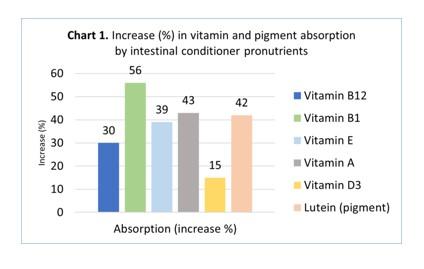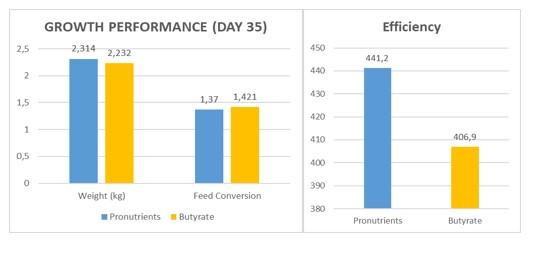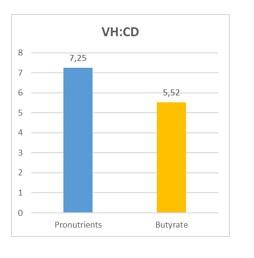Optimization of intestinal physiology, performance and efficiency of poultry farming
Published: July 2, 2021
By: Maria Soriano
Intestinal welfare is one of the most important and more complex objectives to achieve and maintain in animal production. In commercial production, the gut is under high pressure because of the metabolic effort and challenging agents present, which may favor intestinal imbalances and the reduction of nutrient utilization, decreasing production efficiency. Therefore, a good status of intestinal health is key for a sustainable and profitable poultry production, and the reinforcement of intestinal physiology and the balance of gut microbiota are basic to minimize the impact of constant challenges.
Intestinal integrity is defined as the maintenance of the anatomic structure of cells as well as their absorption and defensive functions. By working on a proper intestinal integrity, nutrient absorption can be maximized, which is especially important with the current rising costs of raw materials.
PRONUTRIENTS TO IMPROVE INTESTINAL PHYSIOLOGY
Pronutrients are active molecules from plant origin able to improve animal’s physiology without having a pharmacological effect. Pronutrients act through a metagenetic mechanism of action, through the induction of specific gene expression that leads to an increased synthesis of functional proteins in their target cell.
Furthermore, they have several additional advantages: as they are a natural solution, there is no risk of resistances and no residues are left in products, thus, they do not need a withdrawal period.

Intestinal conditioner pronutrients have the enterocytes as their target cells, and they stimulate the expression of certain genes (CD1E, RIMBP2, among others) in the enterocytes related to different functions: defensive ones, such as cell adhesion (reinforcement of tight junctions) and proliferation (mucosa regeneration) and others related to nutrient absorption and metabolism.
EFFECT OF PRONUTRIENTS ON NUTRIENT ABSORPTION
Molecular and cellular studies have been performed to define the positive effect of pronutrients on gene expression, intercellular adhesion (tight junctions), as well as the absorption of nutrients, like vitamins and pigments (chart 1), and amino acids like lysine and tryptophan, whose absorption was increased by 3.9% and 5.3%, respectively.

EFFECT OF PRONUTRIENTS ON PERFORMANCE AND GUT WELFARE
Among the available strategies to promote intestinal welfare and animal performance without the use of drugs, pronutrients stand out as the first one because of their in vitro results, as well as the in vivo trials comparing them to other substances claiming similar properties.
The effect of pronutrients on the optimization of nutrient absorption has been tested in live animals, both in experimental research and commercial farming, in worldwide institutions and livestock companies, with an important focus in Asia.
A trial performed in broiler chickens in India showed that the use of pronutrients at 0.5 kg/t allowed to increase the final weight by 82 g/bird and reduce the feed conversion by 3.55% compared to a solution based on butyrate (Chart 2). The Efficiency Index of pronutrients group was 61.5 points higher than butyrate group (Chart 3). Results obtained in this trial indicated that a farm could produce 63.3 more tons of meat while saving 159 tons of feed per one million broiler chicken thanks to the use of intestinal conditioner pronutrients.
Charts 2 and 3. Growth performance and efficiency of an experimental trial in broiler fed pronutrients or butyrate in India.

Morphometry of the intestine has been usually used as a reference method to assess intestinal integrity and absorption capacity, taking into consideration the height of the villi (VH), the depth of the crypts (CD) and the ratio between them (VH:CD). A higher VH:CD ratio is related to gut health and more nutrient absorption.
Gut morphometry was evaluated in the two groups, and the villus height/crypt depth ratio in the duodenum was 30% higher when using pronutrients, compared to butyrate (Chart 4), corroborating the effectivity of intestinal conditioner pronutrients on enhancing integrity and absorption capacity of the intestine.
Chart 4. Villus height/crypt depth ratio in the duodenum of broiler fed pronutrients or butyrate in India.

CONCLUSIONS
Intestinal welfare, including gut integrity and balanced microbiota, are key to ensure that birds can use the nutrients in the intestinal lumen up to their maximum potential.
Intestinal conditioner pronutrients stand out as an essential molecule to enhance the integrity and welfare of the gut in poultry. These pronutrients cause a physiological activation of the cells in the digestive mucosa, optimizing their functions and enhancing the defense barrier and nutrient absorption at an intestinal level.
Multiple experimental and commercial trials prove that pronutrients, added in the diets and/or in the drinking water, enhance the gut morphology and function and, therefore, improve the performance and efficiency of the production cycle. Additionally, these studies show that pronutrients are more effective than other products, such as butyrate, as they obtain over 3% improvement on final weight and feed conversion compared to the latter.
Intestinal conditioner pronutrients were developed and patented by Biovet S.A. and are marketed under the name Alquernat Nebsui. This product is available as premix powder and oral solution in Asia.
Related topics:
Authors:
Biovet-Alquermes
Recommend
Comment
Share
Sanluc International nv
11 de julio de 2021
I guess there is a mistake in calculation on the broiler efficiency index.441.2 - 406.9 = 34.3 pts instead of 61.5 ? Could your share the detailed trial protocol and the way this efficiency index was calculated
Recommend
Reply
Biovet-Alquermes
6 de julio de 2021
Hello Mr George, thanks for your message. It is a coated butyrate salt. The article includes part of the experiment, pending to present the full trial results in conferences. Should you like to know more about it, you can write me at msoriano@biovet-alquermes.com.
Recommend
Reply
4 de julio de 2021
Hello Maria,
The Butyrate that was being compared was it a free form, salt or glyceride form?
And would these results be published in some journal I could read ?
Recommend
Reply
15 de octubre de 2023
What kind of plants are pronutrients? Would this product be available in north America?
Recommend
Reply
Premier Feed Mills
11 de octubre de 2021
Thanks for the presentation. Do you have this Pronutrient product in available packs for small holder farmers and if possible through Oral Administration?
Recommend
Reply

Would you like to discuss another topic? Create a new post to engage with experts in the community.













.jpg&w=3840&q=75)